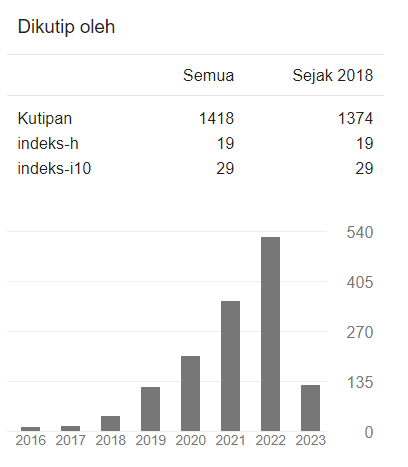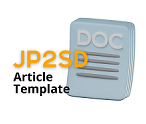Analisis Penerapan Model Pembelajaran Project Based Learning Berbasis Content Video Pada Pembelajaran Konsep Dasar Sains Mahasiswa
DOI:
https://doi.org/10.22219/jp2sd.v10i1.19850Abstract
The project-Based Learning (PjBL) model is a learning model that identifies, through research, real-world problems, from local to global, and develops solutions using evidence to support claims, offers solutions using multimodal approach to a presentation based on a set of 21st century skills. This research aims to analyze the application of the Project-Based Learning (PjBL) model based on video content in learning the basic concepts of science for students. This descriptive research uses phenomenological approach, which is a study that describes the meaning of individuals regarding their experience of a concept or phenomenon. The data collection techniques are conducted through observation, interviews, and documentation. The interactive analysis model from Matthew B Miles and Hubermen is used for data analysis. The model technically consists of 4 (four) main phases: data collection, data reduction or simplification, data presentation, and conclusion or verification. The analysis results show that the implementation of the PjBl learning model is effective, as seen from the students activities which closely complies to the steps. In addition, students are more creative, active, and innovative in learning science and show more confidence. Students are also more independent in learning about the topic they are interested in and becoming tutors for their friends
Downloads
References
Bell, Stephanie (2010) Project-based learning for the 21st century: skills for the future. The Clearing House, 83, pp. 39–43 DOI. 10.1080/0009865090350 5415.
Brame, C. J. (2016). Effective educational videos: Principles and guidelines for maximizing student learning from video content. CBE Life Sciences Education, 15(4), es6.1-es6.6. https://doi.org/10.1187/cbe.16-03-0125
Chiang, C. L., & Lee, H. (2016). The Effect of Project-Based Learning on Learning Motivation and Problem-Solving Ability of Vocational High School Students. International Journal of Information and Education Technology, 6(9), 709–712. https://doi.org/10.7763/ijiet.2016.v6.779
Coil, D., Wenderoth, M. P., Cunningham, M., & Dirks, C. (2010). Teaching the Process of Science : Faculty Perceptions and an Effective Methodology. 9, 524–535. https://doi.org/10.1187/cbe.10
Dadi Sri, Nani Yuliantini, Panut Setiono. 2020. JP2SD (Jurnal Pemikiran dan Pengembangan Sekolah Dasar),Vol. 8 , No 1, April2020hlm 10-18. https://doi.org/10.22219/jp2sd.v8i1.10971
Dewanti, S. R., & Sujarwo, S. (2021). Development of Instagram and YouTube Content Videos’ for Online Learning. Jurnal Penelitian Ilmu Pendidikan, 14(2), 181–188. https://doi.org/10.21831/jpipfip.v14i2.40253
Efstratia, D. (2014). Experiential Education through Project Based Learning. Procedia - Social and Behavioral Sciences, 152, 1256–1260. https://doi.org/10.1016/j.sbspro.2014.09.362
Haryudo, L Nurlaela, M Sondang , Ekohariadi, Munoto. (2019). The effect of motivation in learning used an electric installation automation trainer based on Project Based Learning. International Conference on Education, Science and Technology. Journal of Physics: Conference Series. doi:10.1088/1742-6596/1387/1/012076
Hung, C.-M., Hwang, G.-J., & Huang, I. (2012). A Project-based Digital Storytelling Approach for Improving Students' Learning Motivation, Problem-Solving Competence and Learning Achievement. Educational Technology & Society, 15 (4), 368–379
Krajcik, J. S., & Czerniak, C. M. (2018). Teaching Science in Elementary and Middle School (5th ed.). Taylor & Francis. www.routledge.com/cw/krajcik
Miles, M. B., & Huberman, A. M. (1994). Qualitative data analysis: An expanded sourcebook. sage.
Mohamadi, Z. (2018). and electronic project-based learning on the development and sustained development. Journal of Computing in Higher Education, 30(2), 363–385. https://doi.org/10.1007/s12528-018-9169-1
Munandar, Utami. 2018. Pengembangan Kreativitas Anak Berbakat. Jakarta: Rineka Cipta
Nuraini , Wawan Muliawan. (2019). Development of Science Learning with Project Based Learning on Science Process Skill : A Needs Analysis Study. The 5th Hamzanwadi International Conference of Technology and Education. doi:10.1088/1742-6596/1539/1/012055
Nurdiansah, S , S Kartadinata, E Maryani and N Supriatna. (2019). Collaboration learning: project-based learning and local wisdom. International Geography Seminar. OP Conf. Series: Earth and Environmental Science. doi:10.1088/1755-1315/683/1/012040
Novita L, Fitri K, Khanza R. Penerapan Media Game Ular Tangga Digital untuk Meningkatkan Hasil Belajar Tematik. JP2SD (Jurnal Pemikiran dan Pengembangan Sekolah Dasar),Vol. 8, No2, September 2020,hlm170-178. https://doi.org/10.22219/jp2sd.v8i2.12329
Pietrocola, M., & Gurgel, I. (2017). Crossing the Border of the Traditional Science Curriculum Innovative Teaching and Learning in Basic Science Education. SENSE PUBLISHERS ROTTERDAM / BOSTON / TAIPEI.
Retno, R. S., & Yuhanna, W. L. (2018). Implementasi green living berbasis scientific inquiry pada pembelajaran ipa terhadap kinerja ilmiah mahasiswa. Premiere Educandum : Jurnal Pendidikan Dasar Dan Pembelajaran, 8(1), 31. https://doi.org/10.25273/pe.v8i1.2087
Rohana Rs. (2016). Penerapan Model Project Based Learning Dalam Upaya Meningkatkan Kemampuan Berpikir Kreatif Dan Penguasaan Konsep Peserta Didik Pada Materi Pencemaran Lingkungan. InProsiding Seminar NasionalInovasi Pendidikan Aug 6.
S. Velayutham, J. M. Aldridge, and B. J. Fraser. 2011. Development and validation of an instrument to measure students' motivation and self-regulation in science learning,” International Journal of Science Education, vol. 33, no. 15, pp. 2159-2179,
Saefudin. A. A. (2014). Pengembangan Kemampuan Berpikir Kreatif Siswa Dalam Pembelajaran Matematika Dengan Pendekatan Pendidikan Matematika Realistik Indonesia (PMRI). AlBidāyah, Vol 4 No. 1, Juni 2012: 37-48.
Sari, R. T., & Jusar, I. R. (2017). Analisis Kebutuhan Modul Pembelajaran IPA Berorientasi Pendidikan Karakter Melalui Pendekatan Quantum Learning di Sekolah Dasar. Bioedukasi (Jurnal Pendidikan Biologi), 8(1), 26-32.
Shalihah, N H; Dafik; Prastiti, T D. (2020). The analysis of the application of learning materials based on project-based learning to improve the elementary school students’ creative thinking skills in solving contextual division problems. Journal of Physics: Conference Series; Bristol Vol. 1563, Iss. 1, (Jun 2020). DOI:10.1088/1742-6596/1563/1/012044
Skliarova, I. (2021). Project-Based Learning and Evaluation in an Online Digital Design Course. Electronics, 10, 646. https://doi.org/ electronics10060646
Subekti, H., Taufiq, M., Susilo, H., Ibrohim, I., & Suwono, H. (2018). Mengembangkan Literasi Informasi Melalui Belajar Berbasis Kehidupan Terintegrasi Stem Untuk Menyiapkan Calon Guru Sains Dalam Menghadapi Era Revolusi Industri 4.0: Revieu Literatur. Education and Human Development Journal, 3(1), 81-90.
Subahan, M., & Ismail, M. (2017). Pedagogi Abad ke21. Selangor: Percetakan Jiwabaru Sdn. Bhd
Widiana, I. W., Bayu, G. W., & Jayanta, I. N. L. (2017). Pembelajaran berbasis otak (brain based learning), gaya kognitif kemampuan berpikir kreatif dan hasil belajar mahasiswa. JPI (Jurnal Pendidikan Indonesia), 6(1), 1-15.
Yustina, S., Irhasyuarna, Y., & Kusasi, M. (2016). Penerapan Metode Pembelajaran Problem Solving terhadap Kemampuan Berpikir Kritis Siswa pada Materi Koloid Kelas XI IPA SMA Negeri 4 Banjarmasin. Quantum: Jurnal Inovasi Pendidikan Sains, 6(2), 108-118.
Zega, A. (2021). Penerapan Model Project Based Learning (PjBL) dalam Mata Kuliah Konstruksi Bangunan Pada Mahasiswa Prodi Teknik Bangunan IKIP Gunungsitoli. Edumaspul, 5(1), 622–626.
Downloads
Published
Issue
Section
License
Copyright (c) 2022 Jurnal Pemikiran dan Pengembangan Sekolah Dasar (JP2SD)

This work is licensed under a Creative Commons Attribution-ShareAlike 4.0 International License.
Authors who publish with Jurnal Pemikiran dan Pengembangan Sekolah Dasar (JP2SD) agree to the following terms:
- For all articles published in Jurnal Pemikiran dan Pengembangan Sekolah Dasar (JP2SD), copyright is retained by the authors. Authors give permission to the publisher to announce the work with conditions. When the manuscript is accepted for publication, the authors agree to automatic transfer of the publishing right to the publisher.
- Authors retain copyright and grant the journal right of first publication with the work simultaneously licensed under a Creative Commons Attribution-ShareAlike 4.0 International License that allows others to share the work with an acknowledgment of the work's authorship and initial publication in this journal.
- Authors are able to enter into separate, additional contractual arrangements for the non-exclusive distribution of the journal's published version of the work (e.g., post it to an institutional repository or publish it in a book), with an acknowledgment of its initial publication in this journal.
- Authors are permitted and encouraged to post their work online (e.g., in institutional repositories or on their website) prior to and during the submission process, as it can lead to productive exchanges, as well as earlier and greater citation of published work (See The Effect of Open Access).

This work is licensed under a Creative Commons Attribution-ShareAlike 4.0 International License.


















